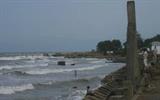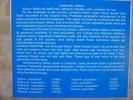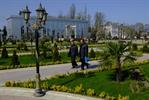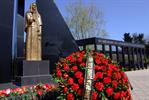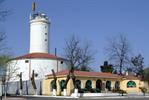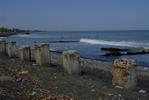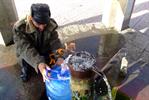In southern Azerbaijan lies the sleepy town of Lankaran (Lenkoran) . Although it is the largest city in the south with a population of 80,000, life here is just a little slower. In the heart of the agricultural centre, the city itself has little to offer for the average tourist. However, a nice stroll through the city may be what the doctor ordered as most people pass through here coming from/going to Iran.
Lankaran is famous for tea and abundant flowers. It has a certain docile charm and sections of seafront have some half-hearted charm, though hiding submerged Soviet detritus.
A symbolic figure is picked out in embossed metal on the wall of the MUM supermarket: a powerful female form holding a tea cup in one hand and a heavy battle-sword in the other. This image of friendship balancing strength appears elsewhere (eg inside the old town double-gate in Baku) but is especially appropriate in Lankaran. To most Azeris, Lankaran is synonymous with tea, and tea is synonymous with hospitality. Tea production has fallen off of late but the hospitality remains as intense and generous as ever. Nonetheless Lankaran does still brandish a sword. It was also the capital of the very short-lived breakaway Talysh-Mugam republic in 1993.
Even though its languorous tree-lined streets seem ill-fitted to any military excitement, the town centre remains home to a big tank regiment, the city's favourite son is not a writer or artist but a battle commander, Hazi Aslanov, who is immortalized in the central square standing atop a symbolic stone tank. Still, the overall atmosphere is tranquil and best summed up by Samet Vurgun
Lankaran smiles with dazzling flowers
Refreshed by tea and welcomed showers
History
Lankaran was the long-time capital of the Talysh Khanate. Like other such khanates, Talysh spent centuries oscillating between independence, Persian control and local confederations until the Russians (who controlled the region between 1728 and 1735) decided it would look nice in their permanent Caspian collection. This left the British in an awkward situation. British troops and engineers had helped fortify Lankaran as part of a mutual defence agreement with Persia. However with the Napoleonic wars in Europe, the Brits temporarily needed Russian support against France and quietly slipped out of town as the Russians advanced in 1813. The Shah's troops were left understrength and rapidly capitulated. But Russian rule proved unpopular.
In 1826 rumours of Tsar Alexander's death set off a rebellion in Lankaran as well as in Karabagh and Ganja. The Persians returned but a Russian counter attack drove them out within a year. By 1828 there were Cossacks in Orumiyeh and Ardebil threatening to advance on Tehran. The Persians sued for peace and signed the Treaty of Turkmenchai on 22 February 1828 which confirmed Russian control over the Talysh khanate.
During the confusion that followed WWI, the Talysh region initially followed Azerbaijan to independence. During April 1919 the region fell under the control ol the Bolsheviks and set itself up as the Talysh Mugam Soviet Republic, only to be forced back into the Azeri Democratic Republic three months later. History repeated itself in August 1993 when the Talysh Mugam republic was declared by Alikram Humbatov, supported by the crack local tank regiment. His 'international declaration of independence' was actually made very informally to a collection of four journalists and seems to have had very little popular support. Again, within three months, the independent republic crumbled. Former mayoress Jamalova arrived at the city hall, carried in on the shoulders of her massed supporters while abandoned Humbatov escaped out of the back door. He is thought to have hidden in the forests around Ballabur Castle in a feeble attempt to draw Babek comparisons, but was later arrested and imprisoned.
What to see
The town's most visible landmark is the whitewashed Mayak - a round-towered operational lighthouse that was a former prison. A similar building near the river bridge said to have once incarcerated Stalin is now used as a carpet-factory warehouse. The khan's palace no longer stands though the History Museum is housed in the elegant former home of Mir Ahmad, one of the khan's dapper descendants. His moustachioed portrait in full bow tie and tails hints at a turn of the 20th-century playboy. He died in France in 1916, just three years after the house was completed. The museum contains a typical series of archaeological photographic and Karabagh memorial items, plus a room decorated to show the interior of a traditional Talysh home.
There are several interesting memorials - the Hazi Aslanov statue in front of the station stands on a white-brick raft supposed to represent a tank. A real tank sits on a plinth by the beach just across the railway line and is now lapped by the waves of the rising Caspian. It's within a closed army area - keep your distance by spotting it from the beach behind the railway station. The central square is dominated by a huge war memorial. Words now removed from the 'heroic tea lady' relief formerly read 'Long live Azerbaijan - the great Soviet state'. The main mosque near the bustling bazaar, is attractive but heavily over-renovated.
The town's heart and social centre stretches from beautifully manicured Dosa Park (renamed Heydar Aliyev memorial Park) to the vaguely quaint train station around which half the town's male population seems to while away their evenings in open-air beer and tea gardens. It is here that the locals come to pass the time, soaking up the sun and basking by the Statue of the Father of the Nation. The park is wonderfully well manicured and is a great place to chill out.
Strolling here amid all the fountains, minutely clipped shrubberies and newly mirror-glassed public buildings is especially surreal at dusk in summer, when lugubrious piped music is played from loudspeakers flanking the new, refreshingly air-conditioned Heydar Aliyev Museum (admission free; 8am-1pm & 2-5pm). The main attraction of the nearby History Museum (S Axundov kuc; admission free; 10am-1pm & 2-5pm Tue-Sun) is the building itself, a century-old brick mansion built in 'Scooby-Doo gothic' style. It looks great when illuminated at night.
A few minutes walk north of the park you'll find a well-done memorial to genocide victims. Azerbaijan has suffered greatly over the years. Largely at the hands of Armenia in times of war. There are a few quotes from the former and current presidents, surprisingly translated into English. But really, other than that, there isn't too much to see or do.
There's a brick-barrel tower just east of the park where Stalin was held prisoner in his early revolutionary days. The sturdy brick-barrel of a tower in which he was incarcerated was under renovation with rumours that it might one day become a tongue-in-cheek Stalin-themed cafe.
Lankaran's beaches can't be recommended for swimming due to chunks of concrete and ruined building parts that remain submerged since the rising Caspian swept away the former Soviet-era promenade. And part of it is offlimits for military use. Slightly nicer seafront areas (though still not really swimmable) are to be found near the Titanic restaurant ( right ) and at Kanarmesha, where two vaguely attractive restaurant gardens overlook the waves.
Getting to Lankaran is super easy. 2 trains a day come from/go to the capital of Baku. The night train comes with "comfortable" sleeping berths. And for only $5 or $6 (depending on which class) it's a total bargain.
Overall, neither Lanakaran nor Astara (border city with Iran)is really worth the trip here alone. There are some hiking opportunities near Lankaran, but they don't really compare to the northern Caucasus mountains. However, if in transit to/from Iran, these towns make for an interesting rest while waiting for the train to Baku.
If you're planning a trip to Azerbaijan you may be interested ▶ Azerbaijan highlights - For those who prefer to go unbeaten path, to explore less visited places and check national charisma of this small country in Southern Caucasus on the edge of Europe.



